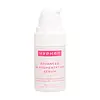What's inside
What's inside
 Key Ingredients
Key Ingredients

 Benefits
Benefits

 Ingredients Side-by-side
Ingredients Side-by-side

Water
Skin Conditioning3-O-Ethyl Ascorbic Acid
Skin ConditioningNiacinamide
SmoothingPropanediol
SolventBetaine
HumectantSodium Hyaluronate Crosspolymer
HumectantSodium Hyaluronate
HumectantSodium Acetylated Hyaluronate
HumectantHydrolyzed Sodium Hyaluronate
Skin ConditioningPentylene Glycol
Skin ConditioningLaminaria Digitata Extract
Skin ProtectingCitrus Reticulata Peel Extract
Skin ConditioningTerminalia Ferdinandiana Fruit Extract
AntioxidantCalendula Officinalis Flower Extract
Masking1,2-Hexanediol
Skin ConditioningHydrogenated Lecithin
EmulsifyingCetyl-Pg Hydroxyethyl Palmitamide
Skin ConditioningCeramide EOP
Skin ConditioningCeramide Ns
Skin ConditioningCeramide NP
Skin ConditioningCeramide As
Skin ConditioningCeramide AP
Skin ConditioningCholesterol
EmollientSodium Citrate
BufferingRosa Damascena Flower Water
MaskingPhenoxyethanol
PreservativeEthylhexylglycerin
Skin ConditioningCitric Acid
BufferingOlive Oil Glycereth-8 Esters
EmollientCyclodextrin
AbsorbentEthoxydiglycol
HumectantMethyl Gluceth-20
HumectantMaltitol
HumectantSodium Acrylates Copolymer
Lecithin
EmollientSodium Gluconate
Skin ConditioningXanthan Gum
EmulsifyingWater, 3-O-Ethyl Ascorbic Acid, Niacinamide, Propanediol, Betaine, Sodium Hyaluronate Crosspolymer, Sodium Hyaluronate, Sodium Acetylated Hyaluronate, Hydrolyzed Sodium Hyaluronate, Pentylene Glycol, Laminaria Digitata Extract, Citrus Reticulata Peel Extract, Terminalia Ferdinandiana Fruit Extract, Calendula Officinalis Flower Extract, 1,2-Hexanediol, Hydrogenated Lecithin, Cetyl-Pg Hydroxyethyl Palmitamide, Ceramide EOP, Ceramide Ns, Ceramide NP, Ceramide As, Ceramide AP, Cholesterol, Sodium Citrate, Rosa Damascena Flower Water, Phenoxyethanol, Ethylhexylglycerin, Citric Acid, Olive Oil Glycereth-8 Esters, Cyclodextrin, Ethoxydiglycol, Methyl Gluceth-20, Maltitol, Sodium Acrylates Copolymer, Lecithin, Sodium Gluconate, Xanthan Gum
Water
Skin ConditioningAnanas Sativus Fruit Extract
Skin ConditioningTranexamic Acid
AstringentGlycyrrhiza Glabra Root Extract
BleachingKojic Acid
AntioxidantPhenoxyethanol
PreservativeSodium Hyaluronate
HumectantMelatonin
AntioxidantAloe Barbadensis Leaf Extract
EmollientCurcuma Longa Root Extract
MaskingHydroxyethylcellulose
Emulsion StabilisingPanthenol
Skin ConditioningSodium Metabisulfite
AntioxidantEthylhexylglycerin
Skin ConditioningSodium Gluconate
Skin ConditioningCitric Acid
BufferingWater, Ananas Sativus Fruit Extract, Tranexamic Acid, Glycyrrhiza Glabra Root Extract, Kojic Acid, Phenoxyethanol, Sodium Hyaluronate, Melatonin, Aloe Barbadensis Leaf Extract, Curcuma Longa Root Extract, Hydroxyethylcellulose, Panthenol, Sodium Metabisulfite, Ethylhexylglycerin, Sodium Gluconate, Citric Acid
Ingredients Explained
These ingredients are found in both products.
Ingredients higher up in an ingredient list are typically present in a larger amount.
Citric Acid is an alpha hydroxy acid (AHA) naturally found in citrus fruits like oranges, lemons, and limes.
Like other AHAs, citric acid can exfoliate skin by breaking down the bonds that hold dead skin cells together. This helps reveal smoother and brighter skin underneath.
However, this exfoliating effect only happens at high concentrations (20%) which can be hard to find in cosmetic products.
Due to this, citric acid is usually included in small amounts as a pH adjuster. This helps keep products slightly more acidic and compatible with skin's natural pH.
In skincare formulas, citric acid can:
While it can provide some skin benefits, research shows lactic acid and glycolic acid are generally more effective and less irritating exfoliants.
Most citric acid used in skincare today is made by fermenting sugars (usually from molasses). This synthetic version is identical to the natural citrus form but easier to stabilize and use in formulations.
Read more about some other popular AHA's here:
Learn more about Citric AcidEthylhexylglycerin (we can't pronounce this either) is commonly used as a preservative and skin softener. It is derived from glyceryl.
You might see Ethylhexylglycerin often paired with other preservatives such as phenoxyethanol. Ethylhexylglycerin has been found to increase the effectiveness of these other preservatives.
Phenoxyethanol is a preservative that has germicide, antimicrobial, and aromatic properties. Studies show that phenoxyethanol can prevent microbial growth. By itself, it has a scent that is similar to that of a rose.
It's often used in formulations along with Caprylyl Glycol to preserve the shelf life of products.
This is the synthetic salt of gluconic acid, a form of PHA and mild exfoliant.
It is mainly used to stabilize oil and butter formulations from going bad. Sodium gluconate is a humectant, pH regulator, and chelating agent.
Chelating agents help neutralize unwanted metals from affecting the formulation.
Sodium gluconate is water-soluble.
Learn more about Sodium GluconateSodium Hyaluronate is hyaluronic acid's salt form. It is commonly derived from the sodium salt of hyaluronic acid.
Like hyaluronic acid, it is great at holding water and acts as a humectant. This makes it a great skin hydrating ingredient.
Sodium Hyaluronate is naturally occurring in our bodies and is mostly found in eye fluid and joints.
These are some other common types of Hyaluronic Acid:
Learn more about Sodium HyaluronateWater. It's the most common cosmetic ingredient of all. You'll usually see it at the top of ingredient lists, meaning that it makes up the largest part of the product.
So why is it so popular? Water most often acts as a solvent - this means that it helps dissolve other ingredients into the formulation.
You'll also recognize water as that liquid we all need to stay alive. If you see this, drink a glass of water. Stay hydrated!
Learn more about Water